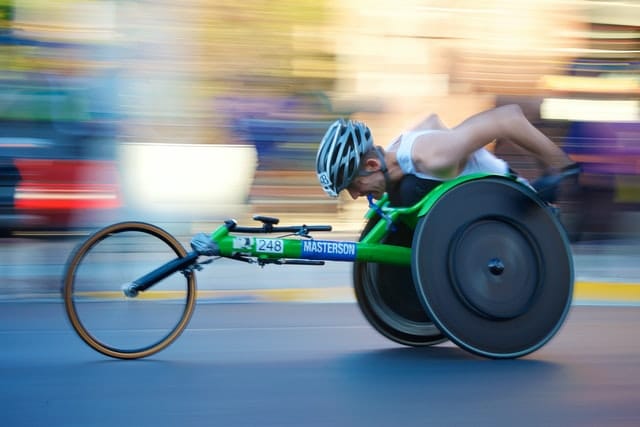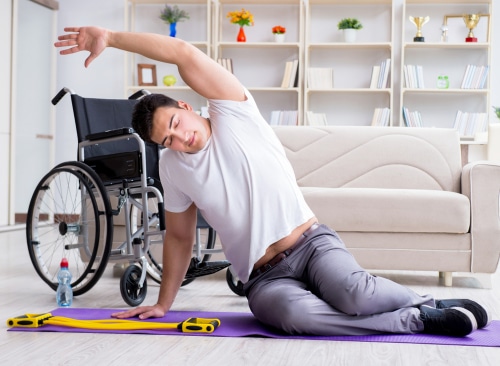We all know how important exercise is for both our physical and mental wellbeing. However, a staggering 85% of Australian adults don’t get enough exercise. Exercising with limited mobility can be challenging, but if you’re able to modify exercise to give yourself a workout, you’ll very likely reap benefits.
Here’s why you should exercise if possible, and some of the types of exercise you might be able to do. Not everybody needs to be the next Dylan Alcott to benefit from exercise!
Of course, these suggestions won’t suit everyone, but we wanted to share our research even if it only helped a few.
Why exercising with limited mobility can be beneficial
The Australian Department of Health says adults should do 2.5 -5 hours of moderate intensity physical activity or 75 to 150 minutes of vigorous intensity physical activity per week.
As you might imagine, adults living with disability are less likely to engage in physical activity. However, everyone, no matter their abilities, has a similar physical need to exercise.
And for good reason. Exercise has a range of benefits including but not limited to:
Simply put, exercise has a range of benefits including but not limited to:
- Improved strength and balance
- Improved mood
- Better sleep
- Reduced chances of developing certain diseases like high blood pressure and diabetes
- Improved stamina
- Improved motor skills
Not enough to convince you that a weekly pilates class or wheelchair basketball game could be beneficial? Remember that exercise may also help you to gain further independence and develop new relationships and friendships.
On the wheelchair basketball front, see if our story on Invictus Games athlete Stephen French inspires you.
How to exercise with limited mobility
The type of exercise you can do will obviously depend to a huge degree on how much mobility you have and your specific disability/ies. While some people might benefit from one type of exercise, others might not.
However, here are some ideas which might set you down the right path. You may need to modify any exercises to fit your unique capabilities.
And it’s always recommended that you work with a doctor, physical therapist, or knowledgeable trainer to help you devise an exercise plan that’s beneficial for your individual needs. They’ll help you figure out what’s best for you.
Seated workouts
It could very well be possible to do some really effective seated workouts. These workouts can be a combination of strength and cardio depending on your unique needs and can be done anywhere and anytime, which is a real benefit.
Seated workouts might be useful if you get fatigued easily. Or if you aren’t able to stand without assistance or your balance is off. Perhaps even if you have knees or ankles that won’t stand up to exercise that involves walking, jumping, or balancing on foot.
Here are 10 exercises which can be done mostly from a chair, along with modifications to help tailor them to suit your disability.
If you’re all about the cardio and want to get your heart and lungs working, here’s a great piece to read. It features five exercises you can do from a wheelchair or other chair. They’ll all give you a good cardiovascular workout

Water workouts
Clearly, water-based workouts aren’t suitable for every person with limited mobility. However, if you’re able to get into – and stay in – the water safely, it can be a great way to exercise with limited mobility.
The buoyancy of the water and the fact that water can help to relieve joint and muscle pain is a big benefit for people with limited mobility. Something like water walking or water aerobics is a good choice. So is swimming if you’re able to do so.
In fact, swimming is advised for all kinds of people who’re recovering from surgery or injuries. Why? Because most of your body weight is supported by the water, so there’s less stress on the joints and body. However, exercising in water still allows you to strengthen and work the body parts that need the workout.
Add to this that water provides resistance, and you have a good avenue for improving strength with lower risk of strain and stress. You could try swimming, water aerobics, or pool walking depending on your disability/ies.
Adaptive sports
Exercising with limited mobility doesn’t mean you have to stick to at-home workouts or boring classes. Nor does it mean you’re relegated to one-on-one sessions with a personal trainer.
From tennis to basketball and everything in between, there’s a huge range of sports out there just waiting for you to give them a try. There might even be some that you’d never thought about attempting.
Why not check out this list of adaptive sports from Disability Sport Australia? If basketball or Aussie Rules isn’t for you, perhaps you’d love something like surfing? Archery? Or even dancing? There are loads of options that will give you all the benefits of exercise and help you to learn a new skill too.
Not to mention providing a great opportunity for you to make some new connections.

Living with disability and need insurance?
If you have a disability converted car or wheelchair accessible vehicle, going through regular insurance providers can be daunting. And expensive. Blue Badge Insurance understands the value of a disability converted car, so you can be confident in your car insurance with us.
We can insure your wheelchair or mobility scooter too.
Plus, if you’re a disability parking permit holder, you’re eligible for up to 25% off your premium with us too.
Exercising with limited mobility – over to you
Have you found a method of exercise that works for you? Let us know on the Blue Badge Insurance Australia Facebook page.








